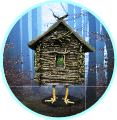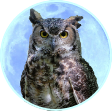






Jones makes effective use of the reader’s expectations of fantasy/fairy tales. Sophie Hatter herself, the feisty hero of Howl’s Moving Castle, is affected by such expectations, as the opening line tells us: “In the land of Ingary, where such things as seven-
When their father dies, their stepmother tells the three girls that they can no long afford to stay in school. Lettie is apprenticed to a pastry cook and Martha to a witch. Sophie will work in the family hat shop. (What job opportunities!)
The villagers learn that an ominous black castle that hovers over the town and moves from place to place belongs to the Wizard Howl, who is said to steal girls’ souls or hearts.
In one of many clever plot twists Sophie visits the pastry shop and learns that the supposed Lettie is actually Martha: the two girls have switched places with the aid of an appearance spell.
A witch casts a spell on Sophie to make her a ninety-
Jones offers subtle twists on fantasy cliches and gives hints of the complicated plot throughout, making clever use of John Donne’s poem “Go and catch a falling star.“ The story is well rounded, with a surprising and satisfying ending. A well written and engaging fantasy throughout, tremendously funny.
The 2004 animated film by Hayao Miyazaki is loosely based on the book.
Jones also wrote The Tough Guide to Fantasyland, makihg fun of the conventions and cliches of fantasy.
Other authors in this vein: maybe J. K. Rowling (who borrows a lot from Jones, though she’s less inventive and a good deal grimmer) and E. Nesbit, who wrote in the early twentieth century and is thus somewhat dated, though still a lot of fun (see the review of her works).
Diana Wynne Jones is one of the most prolific and original fantasy authors. Most of her works are marketed as young adult fantasies but are suitable for everyone. Her urban fantasy Archer’s Goon, for example, was nominated for both World Fantasy Award Best Novel and ALA Best Book for Young Adults. There is great variety in the complexity of her works, but they are almost all highly recommended. Her intriguing characters are more emotionally engaging (especially in The Homeward Bounders), satisfying, and warm-
Archer’s Goon
Dark Lord of Derkholm
The Homeward Bounders
The Ogre Downstairs
Witch Week
and many, many more
Some websites for Diana Wynne Jones:
https://www.fantasticfiction.com/j/diana-
https://www.tor.com/2015/12/16/where-

Howl’s Moving Castle (1986) by Diana Wynne Jones

1st paperback ed.


American edition



Selected Fantasies by Diana Wynne Jones
Cart and Cwidder
Dogsbody
The Lives of Christopher Chant
A Tale of Time City
The Tough Guide to Fantasy Land